6 winning ETFs tipped to take-off
Listed investment companies and exchange-traded funds have had nothing short of a stellar financial year, with funds under management skyrocketing in the 12 months to the end of June.
Despite the renewed spotlight on underperforming LICs (hello, Wilson Asset Management's Strategic Value LIC) the LIC and listed investment trust sector rose by 32% during the year. ETFs also had their strongest year in over a decade, with FUM soaring more than 73%.
Chief executive officer of the Listed Investment Companies and Trusts Association, Ian Irvine, suggested this uplift in LICs and LITs could be attributed to two IPO capital raisings in June (WAM Strategic Value and Salter Brothers Emerging Companies) as well as an overall performance boost from the sector, up 31.4% excluding IPO capital.
“This was driven by both the increasing value of investment portfolios and the share price of the LICs and LITs themselves,” Irvine said.
“There is continuing interest from investors who understand the benefits of the LIC and LIT closed-end fund structure, including its cost efficiency, management stability and focus on the long term.”
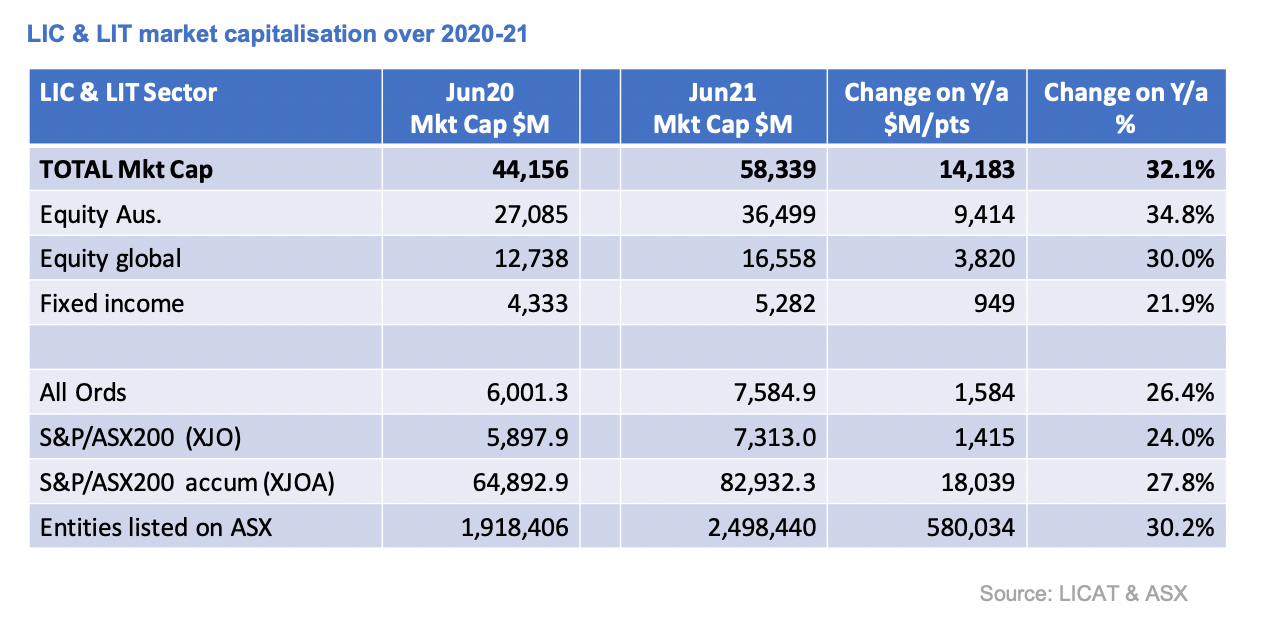
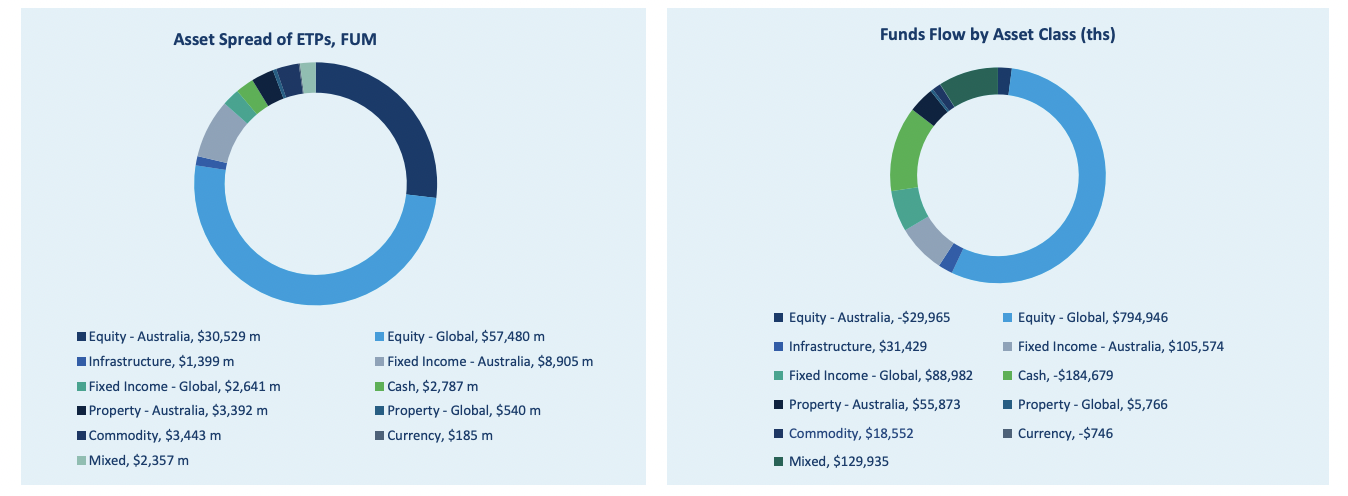
The majority of investments in LICs and LITs remained in Australian equity-focused vehicles, with FUM rising nearly 35% during the financial year to reach $36.5 billion. FUM in global equity LICs also rose during the year, as did those focused on fixed income, up 30% and 22% since the end of June 2020.
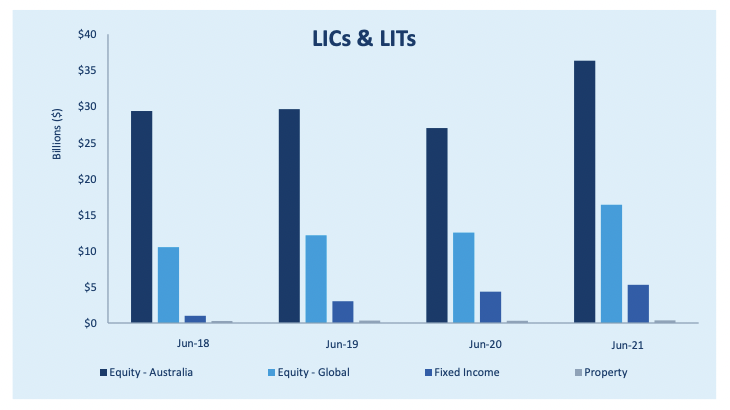
Meanwhile, the FUM of ASX-listed exchange-traded products rose from $65.55 billion to $113.52 billion over the 12 months, with 16 new funds listed during the period - including the recently added Monash Absolute Active Trust ETF (ASX: MAAT) and iShares CORE MSCI Australia ESG Leaders ETF (ASX: IESG).
Unlike the LIC market, investors are predominantly using ETFs to gain global exposure, with FUM for global equity ETFs far surpassing that of Australian Equity ETFs, with FUM up more than 120% from the prior year.
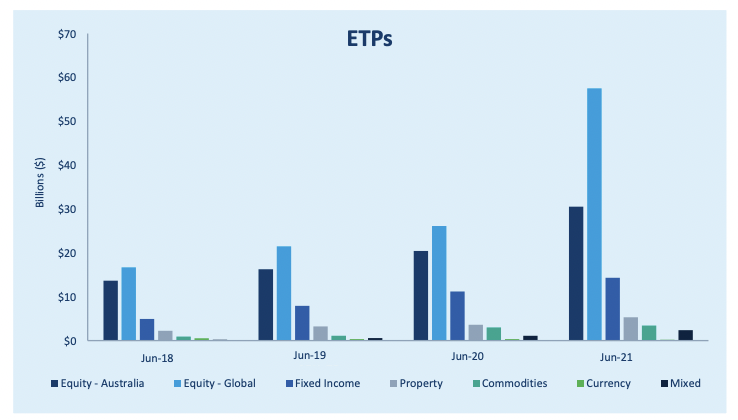
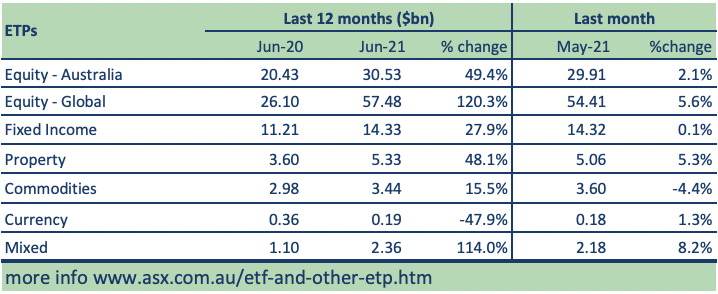
Australian equity ETFs still remain the second most popular option for investors, with FUM up 49.4% during the financial year to reach $30.53 billion.
Vanguard's Asia-Pacific head of ETF Capital Markets, Minh Tieu, said that in the first half of 2021 alone, global equity ETFs recorded $4.9 billion in inflows, while domestic equity-focused ETF inflows were significantly less (69%) at $1.5 billion.
Over the full financial year, over $22 billion of net inflows went into global equities ETFs, versus $4.8 billion in Aussie equities.
"While COVID-19 management differs in effectiveness between countries, investor confidence in overseas markets continues to improve," Tieu said.
“As vaccination rates continue to rise and consumption continues to rebound, Australian investors are looking for ways to capitalise on international growth opportunities with economies reopening."
As demonstrated in the table above, fixed income-focused ETFs also attracted investor interest, with FUM rising 27.9% to $14.33 billion during the financial year.
Which ETFs received the majority of inflows?
Interestingly, the top inflows during the financial year were from pre-existing funds that converted to dual-structure products. For example, Magellan combined an existing active ETF and an unlisted fund into its Magellan Global Fund Open Class (ASX:MGOC). Meantime, another major inflow player was the Hyperion Global Growth Companies Fund (ASX: HYGG), which made its unlisted fund available to investors as an ETF in March this year.
Also receiving the lion's share of inflows was the Vanguard Australian Shares Index ETF (ASX: VAS) and the iShares Core S&P/ASX 200 ETF (ASX: IOZ). While the Vanguard MSCI Index International Shares ETF (ASX: VGS) and the BetaShares Nasdaq 100 ETF (ASX:NDQ) also received hundreds of millions of inflows as investors moved to benefit from the global equity rally.
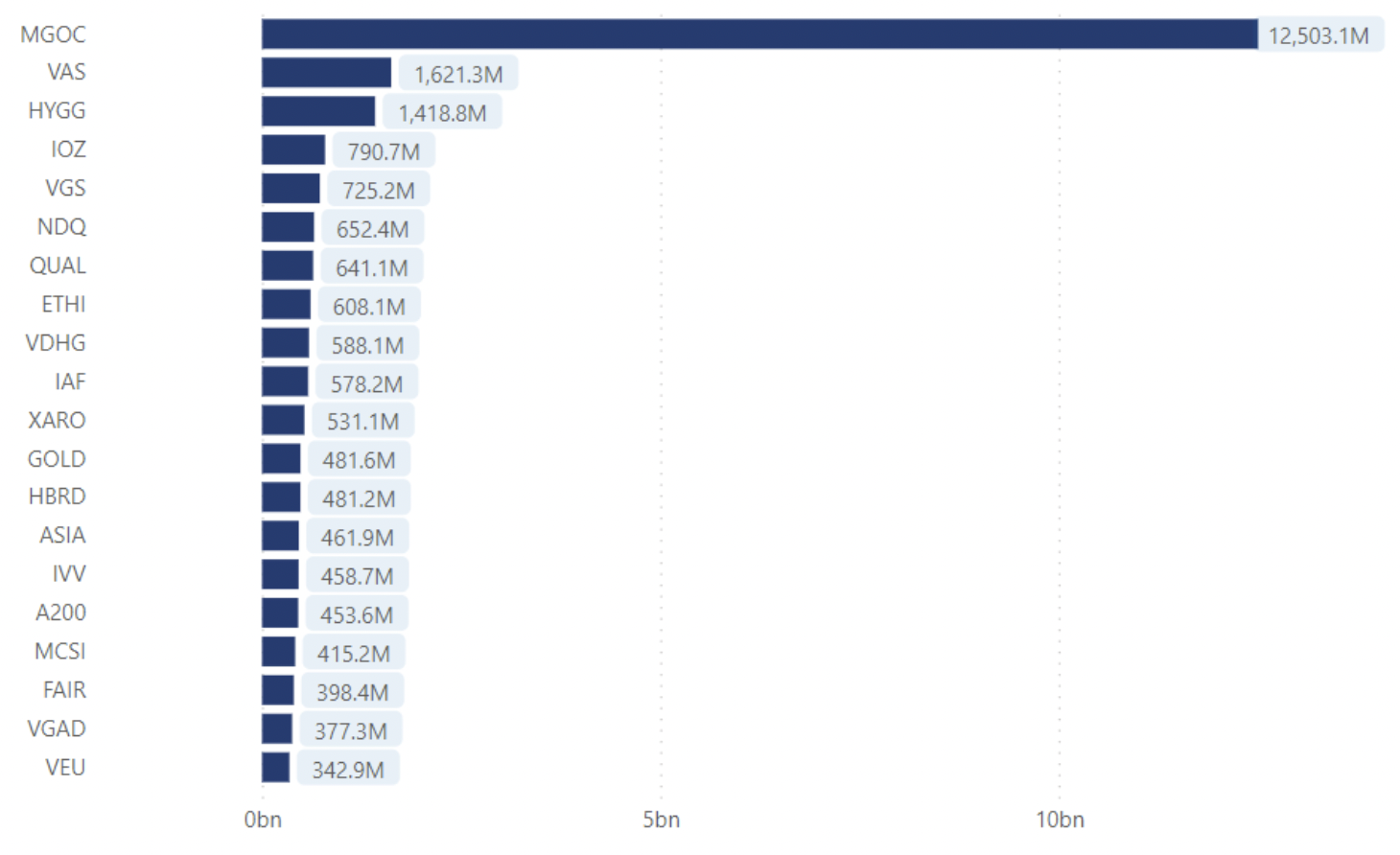
ETF Tracker's Mark Monfort noted that ESG-related ETFs also made a splash in FY21, with $1.7 billion in inflows and total FUM now rising above $4.2 billion.
He points to the BetaShares Global Sustainability Leaders ETF (ASX: ETHI) as a clear winner in the arena, and notes it has the most FUM out of the 21 ESG-focused ETFs on the market. He also references new listings like the Betashares Climate Change Innovation ETF (ASX: ERTH) and the iShares Core MSCI Australia ESG Leaders ETF (ASX: IESG), and impressive performers like the VanEck Vectors Global Clean Energy ETF (ASX: CLNE) and the eInvest Better Future Fund (ASX: IMPQ).
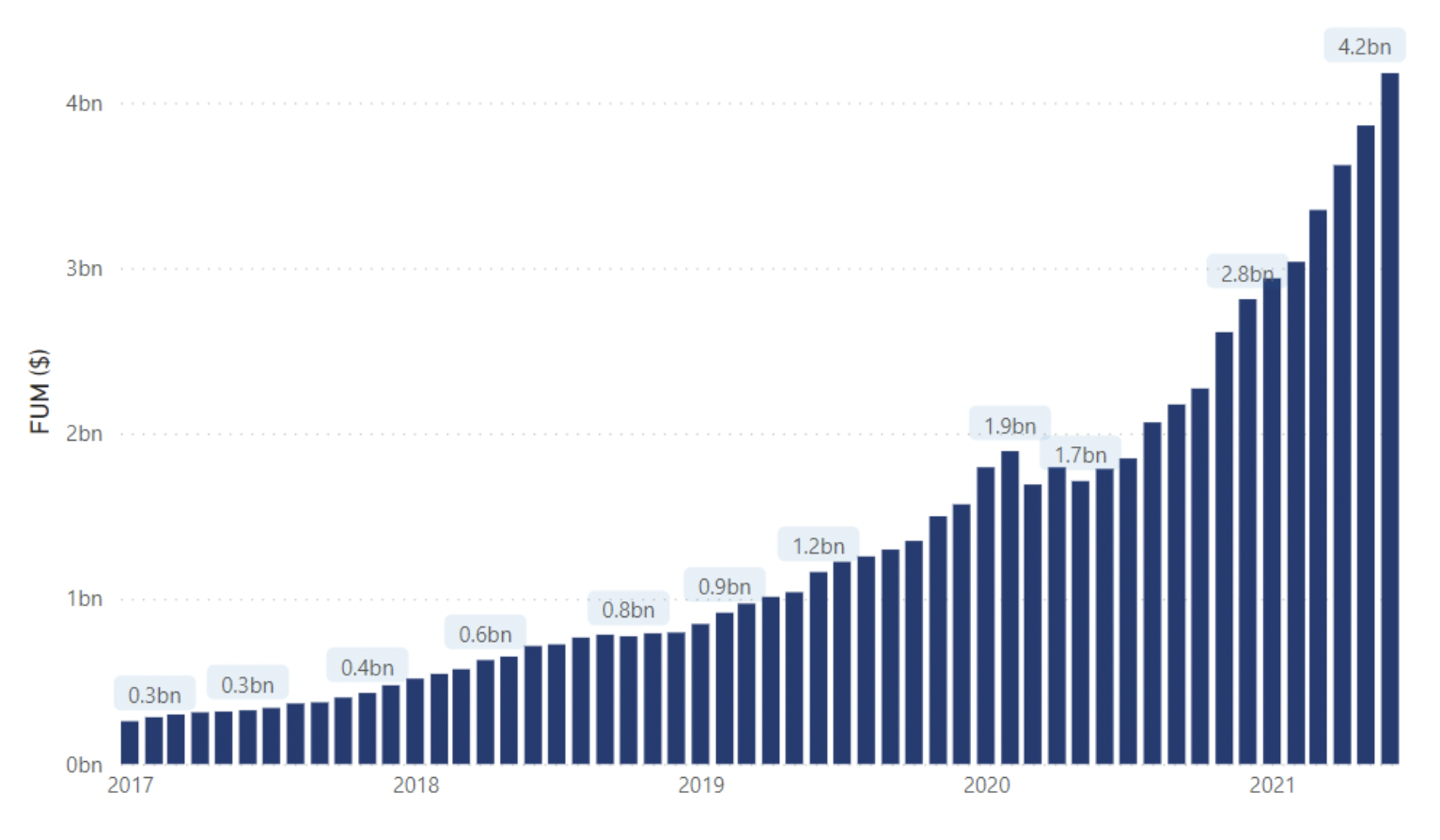
So what's next for ETFs?
According to Statista, there are now US$7.74 trillion in assets under management in ETFs globally, with 7,602 ETFs now listed around the world. In the Asia-Pacific region, there is US$690 billion invested in ETFs.
Monfort believes the Australian ETF market is on pace to reach over $120 billion in FUM by the end of 2021 and points to average monthly inflows consistently over $1 billion for this forecast.
With ESG-focused ETFs reaching $4.2 billion in FUM, he also argues the popularity of these products is only likely to soar higher.
"That’s a 134% year on year increase – compared with overall market which grew 73% year on year," Monfort said.
"We should also see this soar higher as more demand comes from investors. We’re only starting to see that with superannuation and it will be more prevalent with ETFs."
We're also likely to see a Bitcoin ETF on the horizon, Monfort said, with VanEck, BetaShares and Monochrome already pointing to the possibility of an ETF listing for this asset class in Australia.
"However, a possible headwind might be the further delays of the SEC listing one in the US," he said.
6 winning ETFs ready to take flight
Monfort likes technology ETFs with exposure to broad markets, and points to the Betashares Asia Technology Tigers ETF (ASX: ASIA), the BetaShares S&P/ASX Australian Technology ETF (ASX: ATEC) and the BetaShares Nasdaq 100 ETF (ASX: NDQ) as three he is backing.
He also believes the continual rise in the ESG category - as well as more funds doing their bit to help the environment - will help to benefit companies with ESG exposure.
"Given the active and passive benefits, I'd look at the BetaShares Global Sustainability Leaders ETF (ASX: ETHI) or the iShares Core MSCI Australia ESG Leaders ETF (ASX: IESG) in the passive space and eInvest's Better Future Fund (ASX: IMPQ) in active," Monfort said.
Of these, IESG was the first iShares ESG-focused ETF to list in Australia, he said.
"That’s interesting because they had the biggest launch in the history of ETFs with their LCTU fund (US Carbon Transition Readiness ETF)," Monfort said.
"So listing an ESG ETF here in Australia makes for a conversation starter, to say the least."
In comparison, the award-winning IMPQ is better aligned for those looking for active management within the ESG sector, he said.
"It means their portfolio management team actively chat with the management of the companies they invest in and can be well-positioned to avoid the greenwashing we’ve seen talked about as a negative of ESG investing," Monfort said.
More like this:
.jpg)

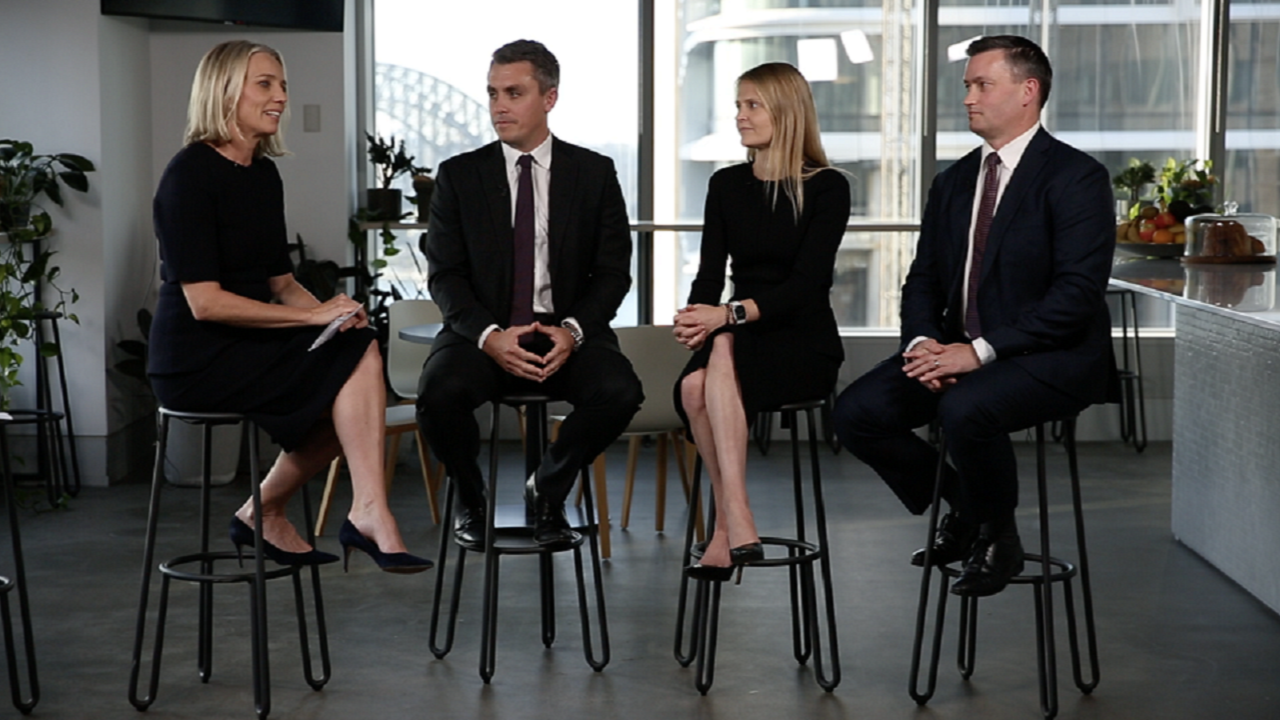
Enjoyed this wire?
Give this wire a like if you've enjoyed the discussion and hit follow to be notified when new episodes are released.
If you're not an existing Livewire subscriber you can sign up to get free access to investment ideas and strategies from Australia's leading investors.
2 topics
9 stocks mentioned
1 contributor mentioned

